Lemon Curd can only be described a nectar for the gods. One of the easiest basic pastry techniques, this sweet and tart intensely flavored curd makes the grocery store version obsolete. And it can easily be made in less than 30 minutes. Used as a topping, a spread or a filling for cakes and tarts, the uses are only up to your imagination.
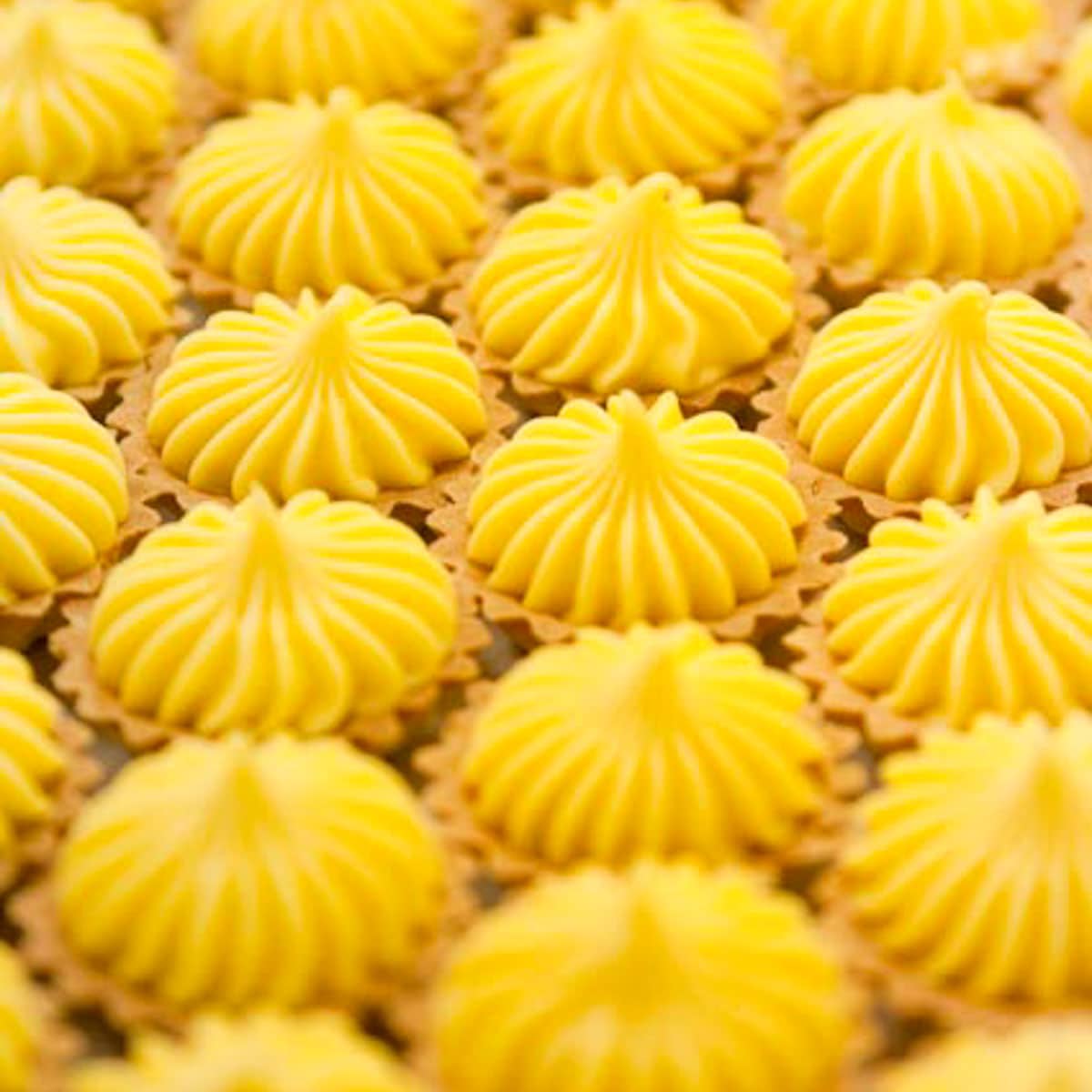
While most lemon curd recipes make a soft, spreadable version, this one is perfect for piping as in the photo above or for standing on its own in a lemon tart that cuts to perfection. For a softer version, omit the gelatin.
The tartlets above were in our petit four box which were sold frozen.
At the bakery, I made a few changes to the normal curd that ensured it would stay firm and stable for cakes and tarts. It never failed. A few ingredients keeps this recipe simple, quickly and easily made to have on hand for whatever you wish.
I found that when we piped the curd for various desserts, I noticed towards the end of each piping bag, it would lose its stiffness and wouldn't hold an edge. So I started adding a bit of gelatin to help keep it stable and allow it to keep its shape when piped even at room temperature. I find it makes all the difference in the world.
This technique actually applies to most curds I have made with the exception of the Cranberry Curd. It does not need a boost from gelatin because it has a lot of natural pectin which sets it. Be sure to check out the Peach Curd Tart, the Chocolate Truffle Raspberry Curd Tart, and the Lemon Gooey Butter Cake in a Brioche Crust as well as the Lemonade Cake.
The amount of the ingredients can change for various recipes, but the technique remains the same.
Jump to:
Why You'll Love This Recipe
- It's foolproof. Period.
- At the bakery, I found that 172°F was the optimum temperature to which the curd should be taken. No guessing, no coating the back of a spoon, just a temperature. Since this recipes does'nt need the zest of the lemon for it's amazing flavor, there is no straining at the end.
- The curd is easy to make. Everything goes in the pot at once. I don’t recommend making this over direct heat as even at the lowest heat, the eggs may scramble making little lumps that don’t come out. The gentle heat of low boiling water not touching the pan keeps the eggs from scrambling. Ten minutes of prep, to minutes of stirring – done!
- The flavor is amazing with just the right amount of tartness
- Lemon curd is a building block in pastry and can be used in many different ways including tarts, pies, cakes, cookies, as fillings or on its own.
- It uses only 5 ingredients for an incredibly bold flavored use anywhere recipe.
How to Use Lemon Curd
- As a filling for cakes, Danish pastry, yeast doughs, tarts, cupcakes, crepes, cookies doughnuts, biscuits or croissant
- Spread on pancakes, scones, or waffles
- Stir it into yogurt, cream cheese, cottage cheese or ricotta
- Swirl through ice cream
- Use it as a topping for pound cakes or pavlova
- Make a Lemon Curd shortcake
- Serve it along side angel food cake
Ingredients
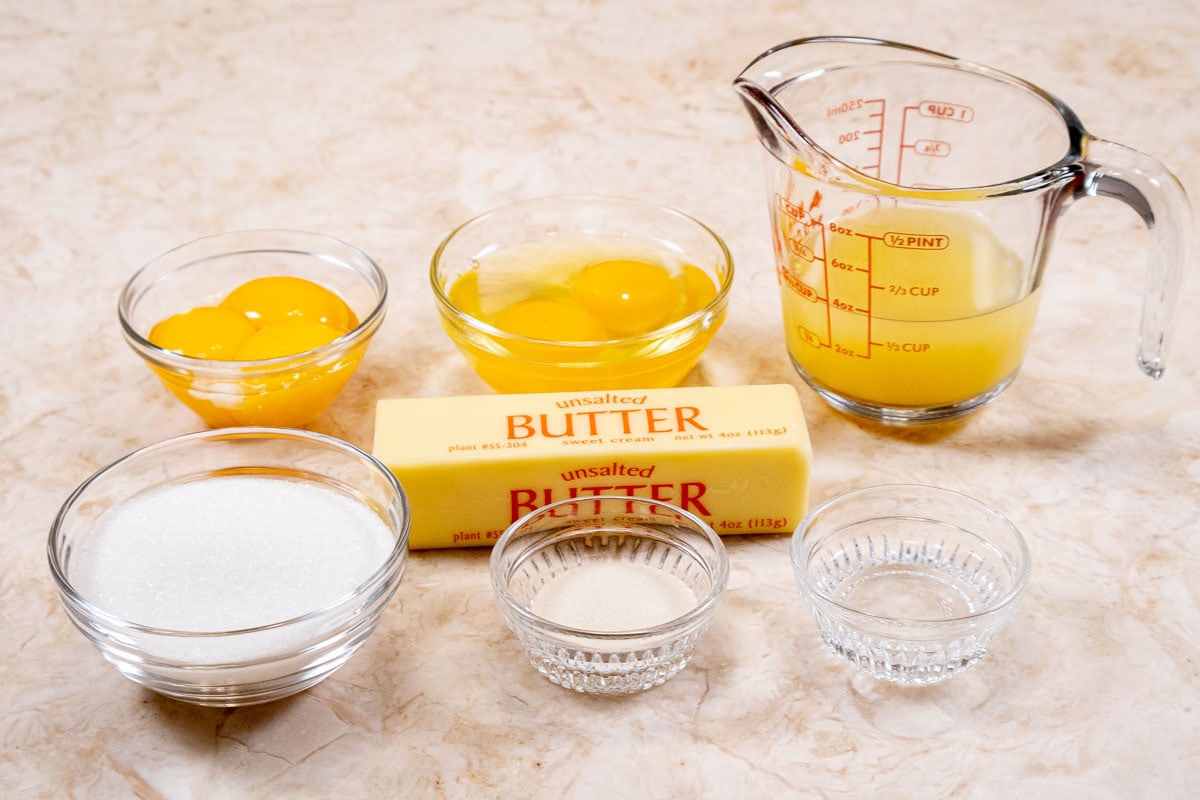
BACK ROW: Egg yolks, whole eggs, lemon juice
MIDDLE ROW: Unsalted Butter
FRONT ROW: Granulated sugar, gelatin, water
Egg yolks thicken the curd. This recipe uses whole eggs plus egg yolks to ensure a firm lemon curd.
Unsalted butter give the curd a silky smoothness that glides on your tongue.
Sugar adds the necessary sweetness to the tartness of the lemons
Lemon juice needs to come from real lemons and not bottled lemon juice
Be sure to see the recipe card below for the full ingredients list and instructions.
Step by Step Instructions
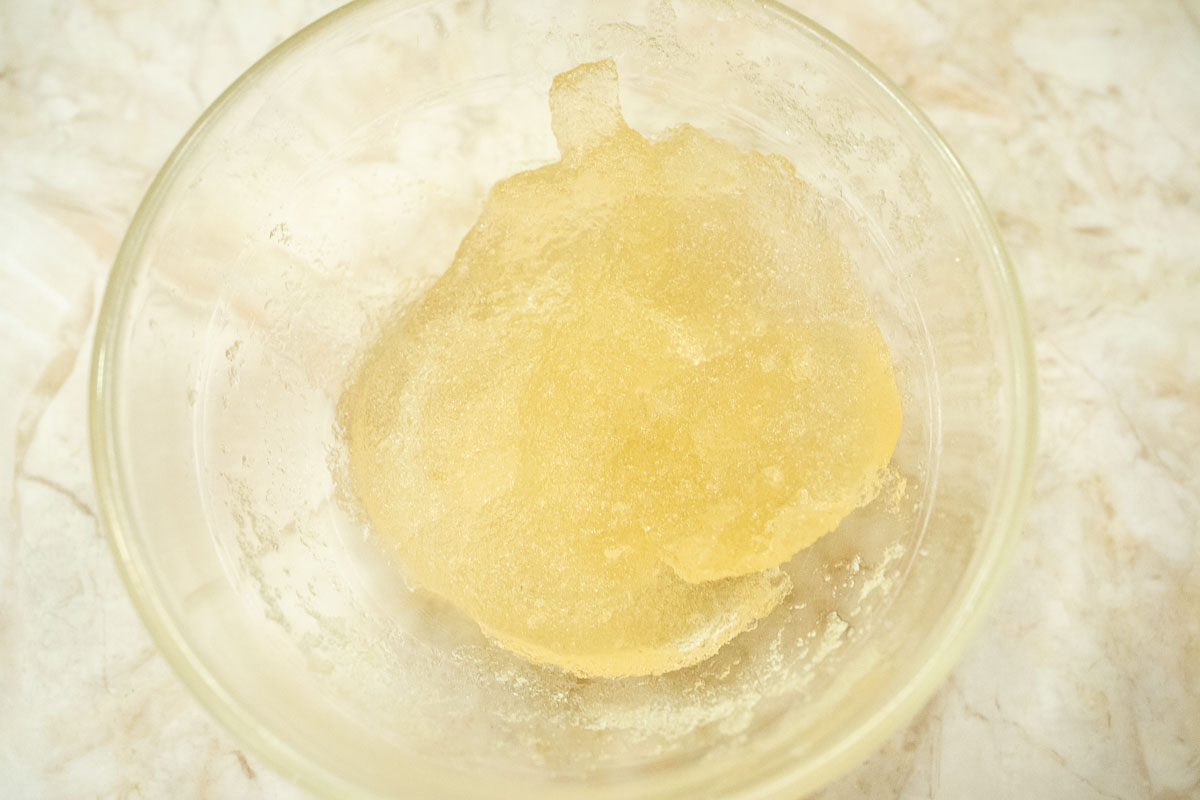
Step 1. Place the water in a very small bowl. Add the gelatin and stir. Make sure all of the gelatin is wet. It will form a gelatinous blob. Set aside.
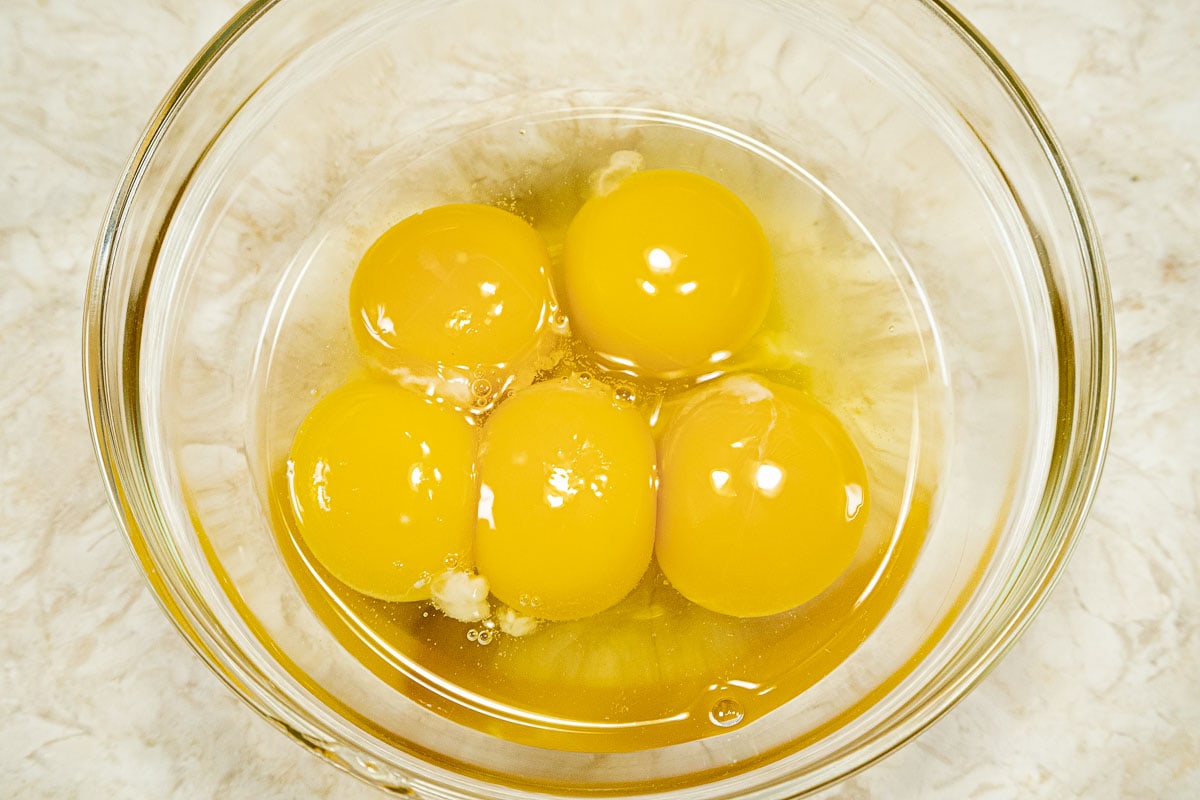
Step 2. Place the eggs and yolks in a medium size bowl.
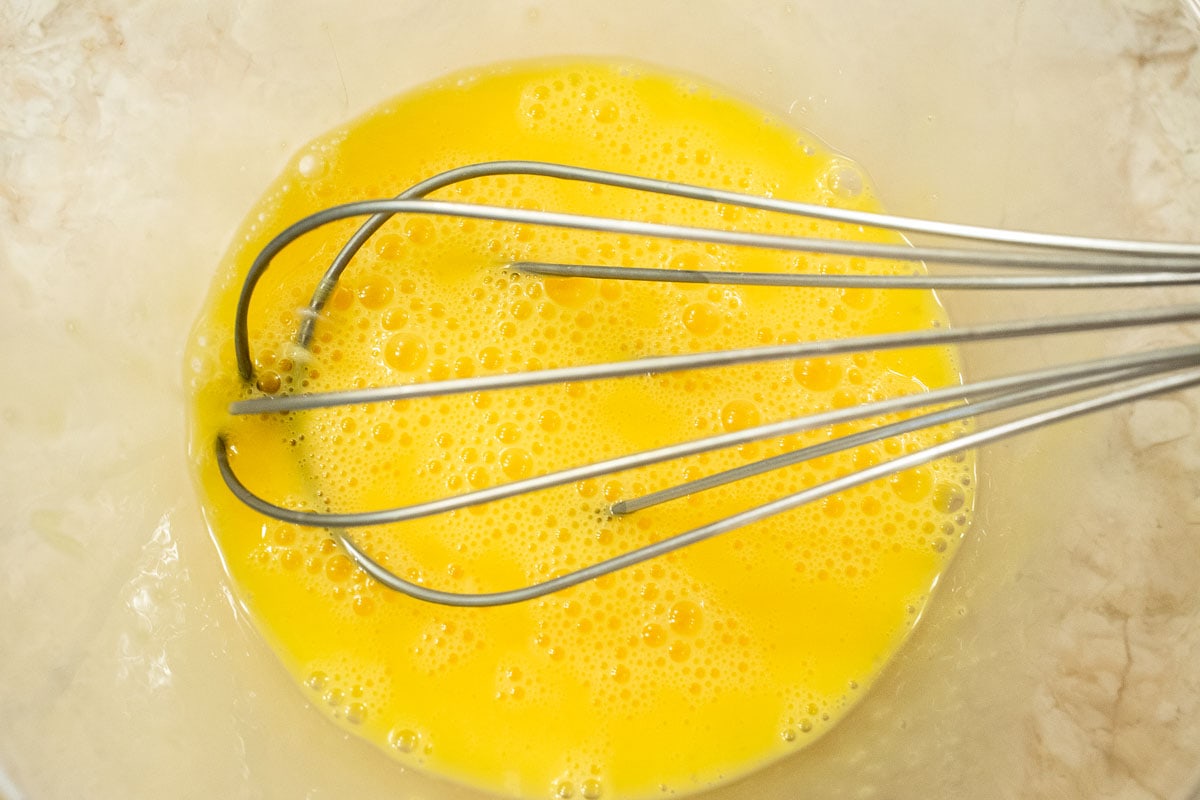
Step 3. Whisk the eggs and yolks until no whites are showing.
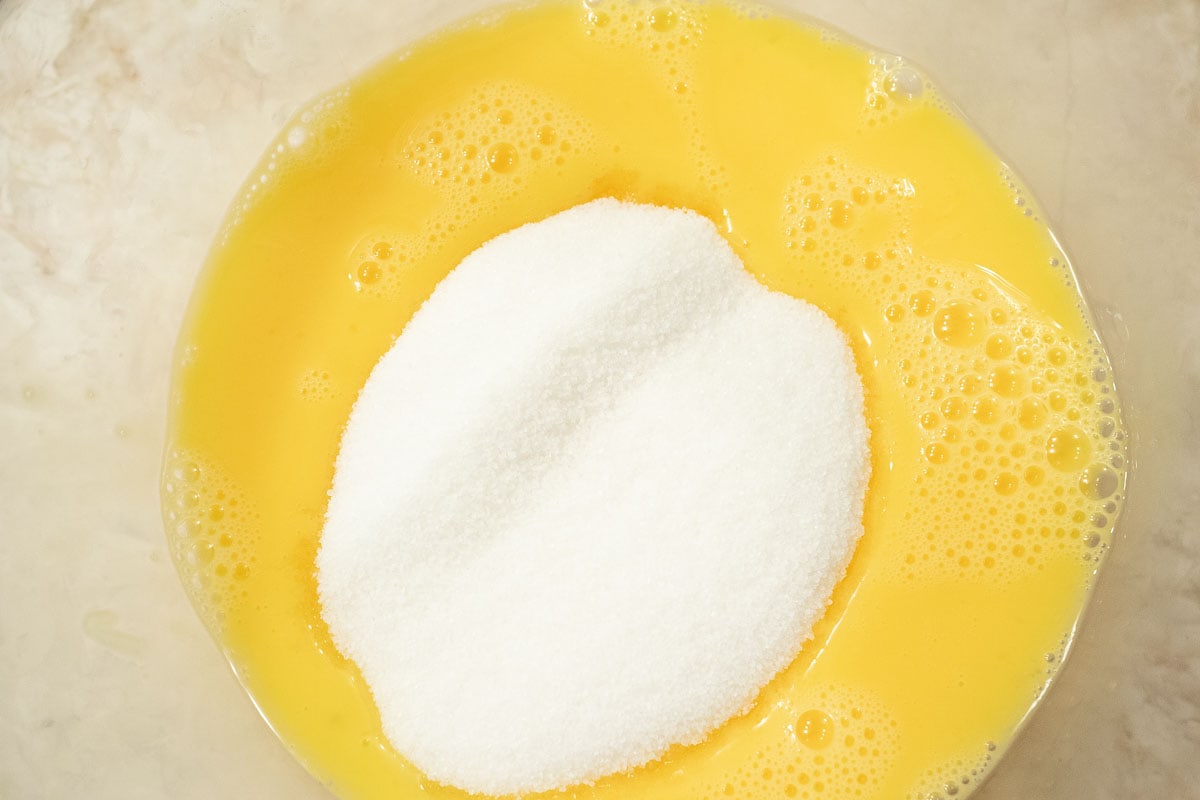
Step 4. Add the sugar and lemon juice to the eggs, whisking to combine.
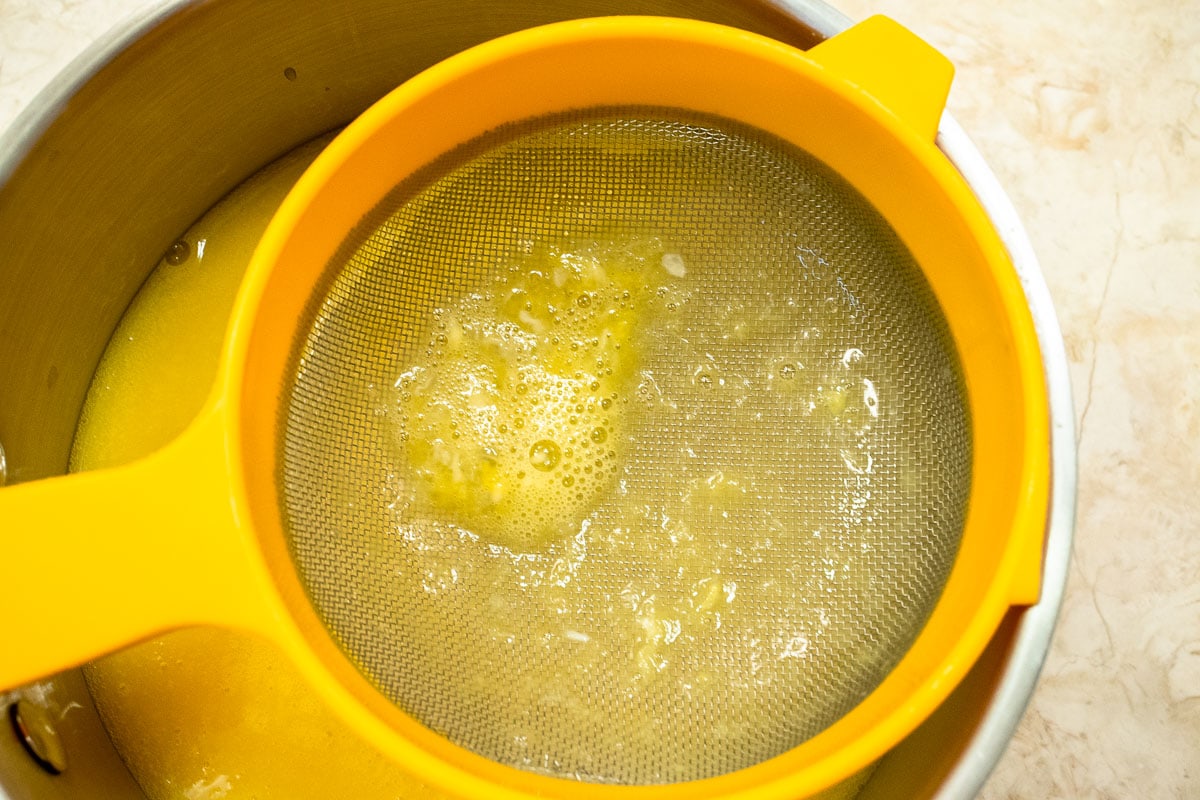
Step 5. Strain the mixture into the top of a double boiler.
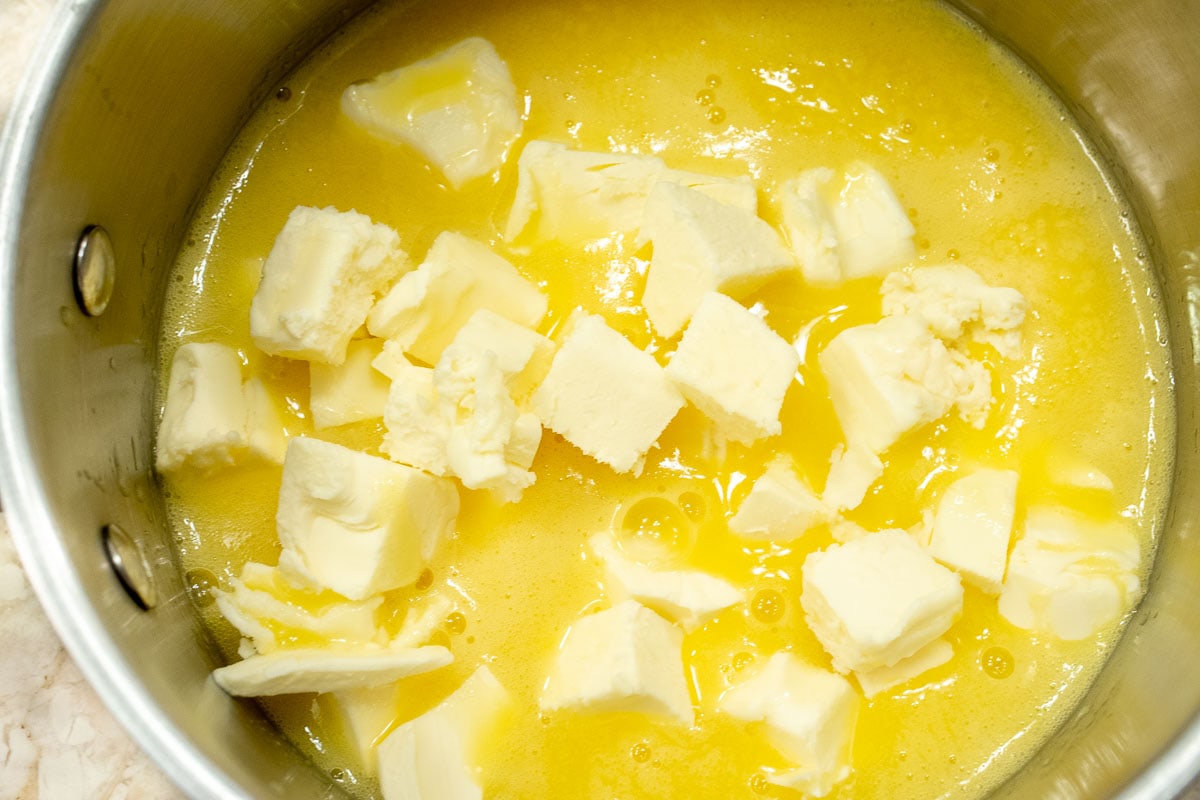
Step 6. Add the butter to the pan and place it over gently boiling water.
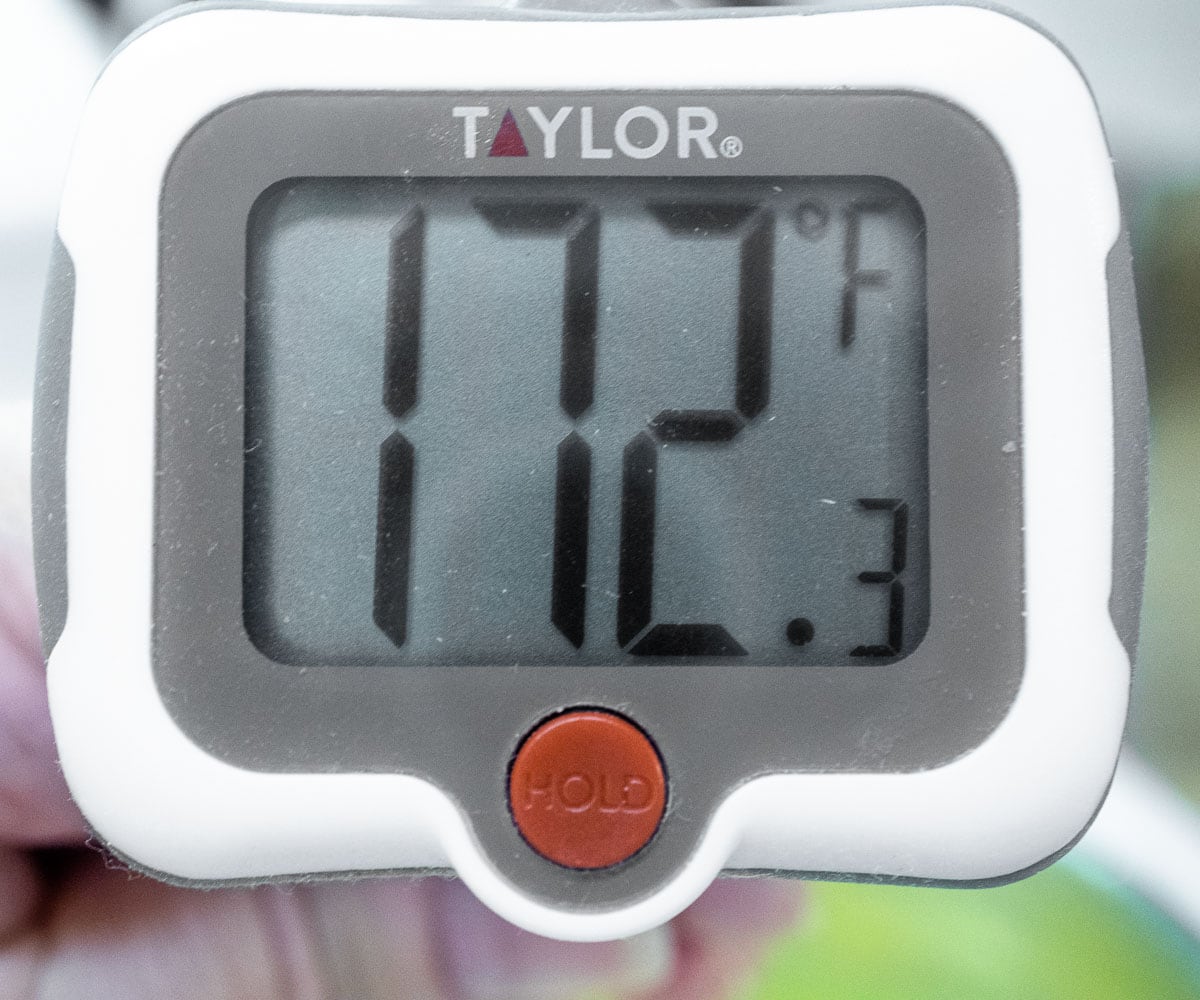
Step 7. Stirring constantly, cook the curd until it reaches 172°·F on a thermometer.
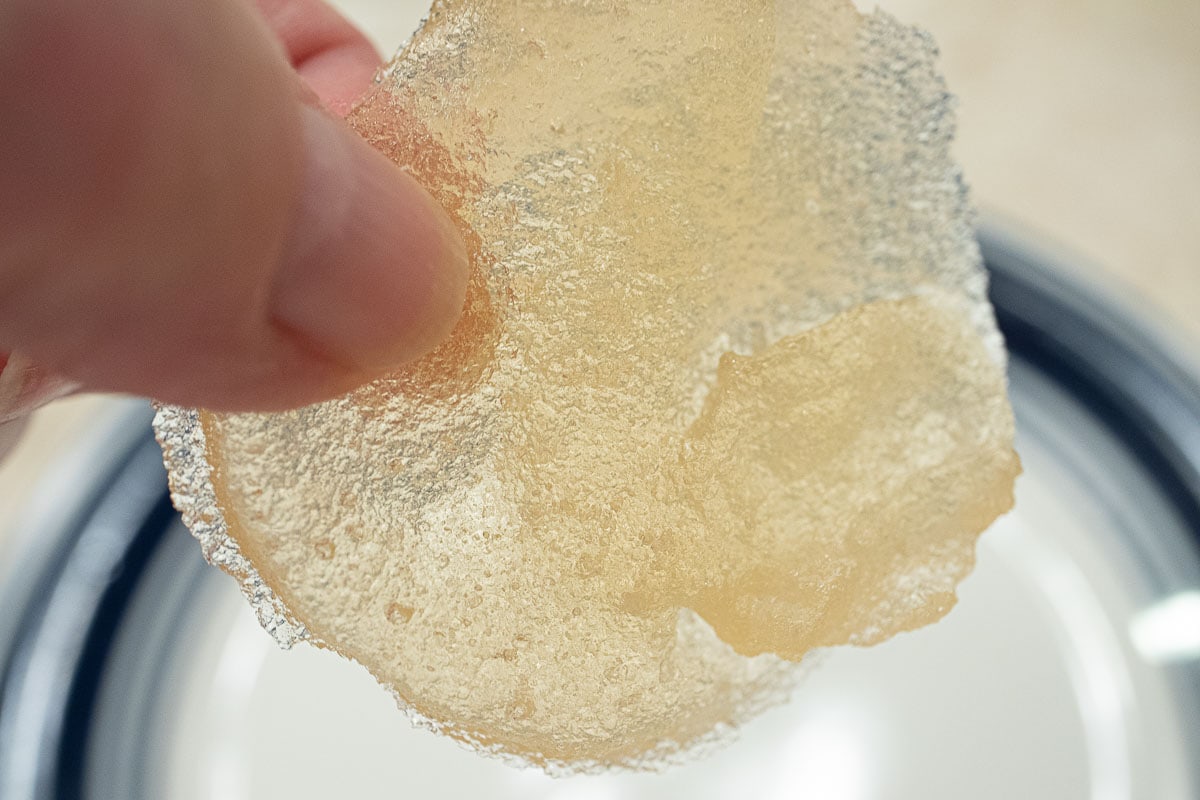
Step 8 . The gelatin has formed a wiggly blob that can be picked up.
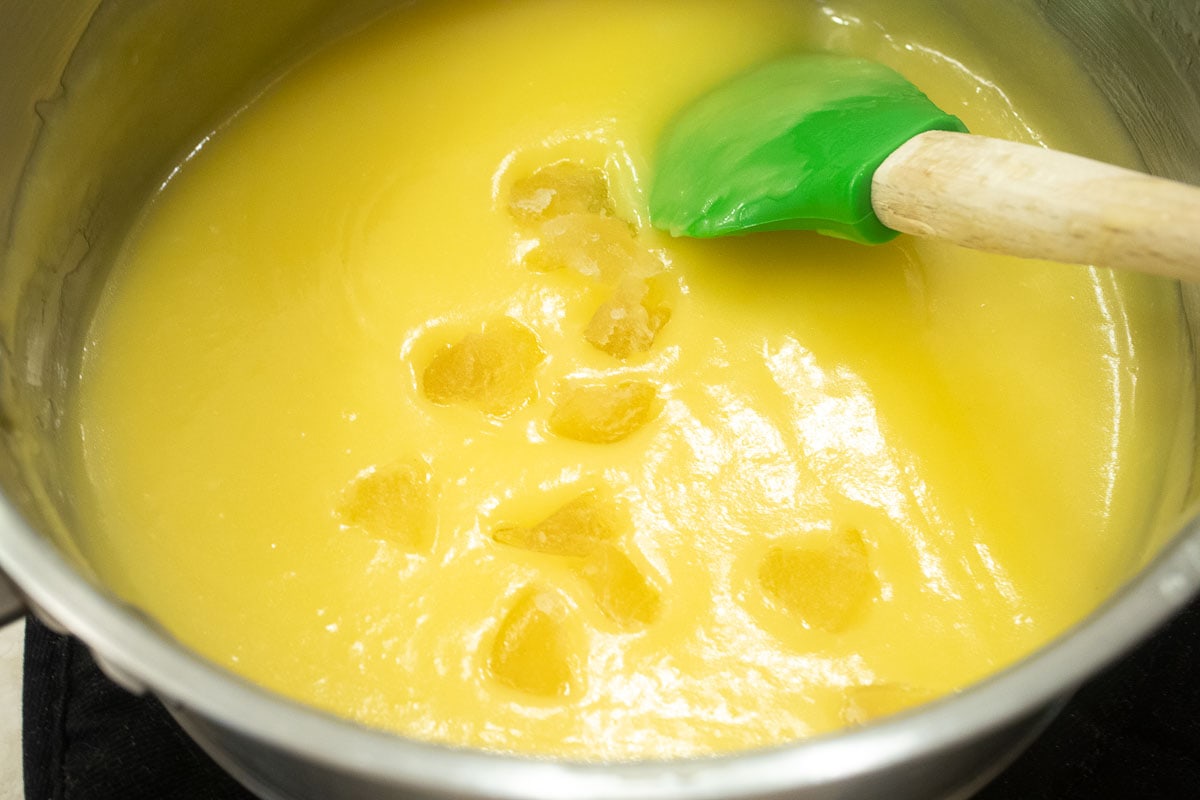
Step 9. Tear the gelatin into small pieces and add it directly to the hot curd. Stir with a spatula until it dissolves and is incorporated into the curd.
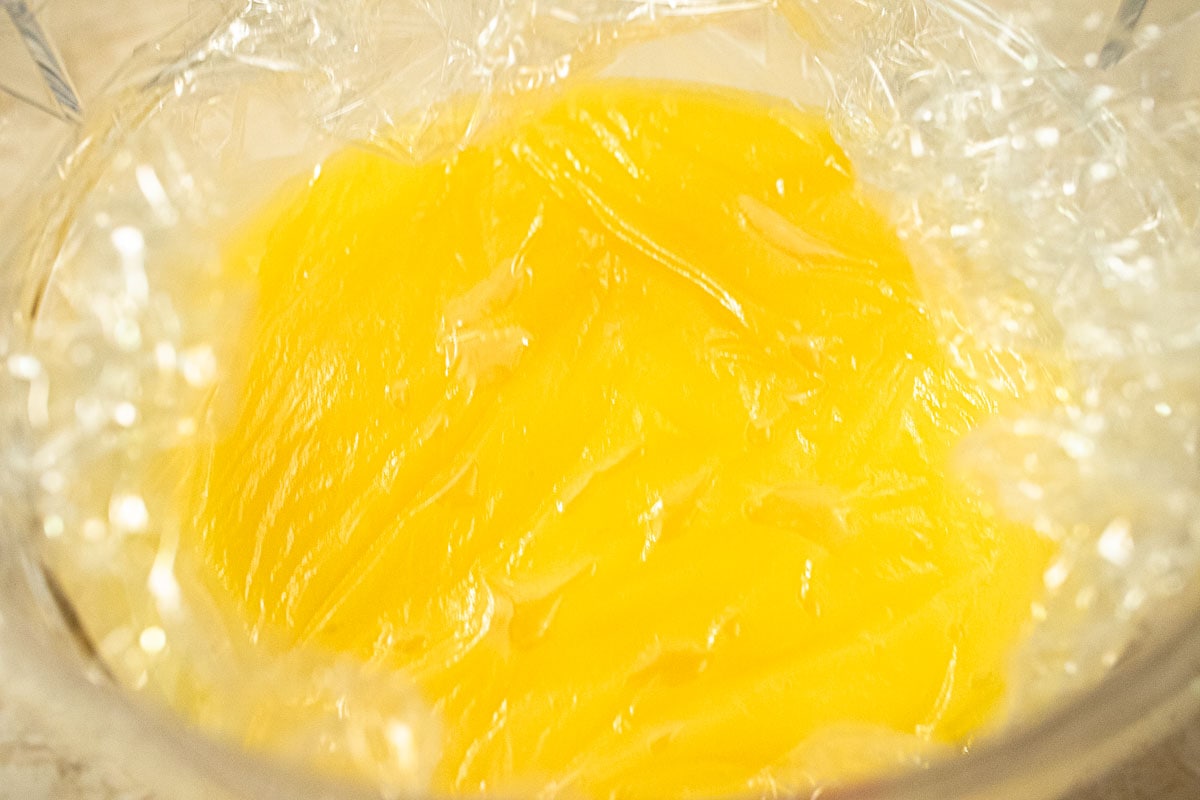
Step 10. Transfer the curd to a bowl or storage container. Place plastic wrap directly on top of the curd to prevent a skin from forming. Cool to room temperature unless a recipe instructs otherwise.
Recipe FAQs
Because of the lemon juice, lemon curd should never be made in an aluminum or copper pot. Doing so causes an unwanted reaction with the aluminum which can not only discolor the curd but also give it a metallic taste.
No. Lemon pie filling is set with cornstarch and is usually firmer than lemon curd which is set with egg yolks. It can also contain a small amount of gelatin.
When grating the zest or rind of any citrus, it is important to only grate the colored skin. The pith or white part below is bitter and will turn anything where it's used bitter.
The only thicken in the curd is the egg yolks. They have to be cooked to 172°F for them to thicken. It is best to depend upon a thermometer for the best results. Conversely, if you cook the curd too long, it will overcook and become lumpy.
Storage
After the curd has cooled to room temperature, store it in the refrigerator for up to a week. For longer storage, freeze it. A really neat idea is to pour it into and ice cube tray where a little can be thawed at a time. Thaw in the refrigerator to use it.
Expert Tips
- Don't be tempted to use bottled lemon juice, it won't taste the same as fresh squeezed.
- If you don't have a double boiler, place a tight fitting bowl over the pan beneath.
- Use a very small bowl to soften the gelatin. If the bowl is too big, the water will spread out and the gelatin will not be able to absorb it.
- Do not put the curd mixture in an aluminum or copper pan or bowl at any point. It can become discolored and have a metallic taste to it.
- Add cold butter to the egg mixture just before placing it over the double boiler. The cold will allow the eggs to heat up slowly, which is also the reason the water is kept at a low boil. If cooked too long or at too high a heat the eggs will set causing a lumpy curd.
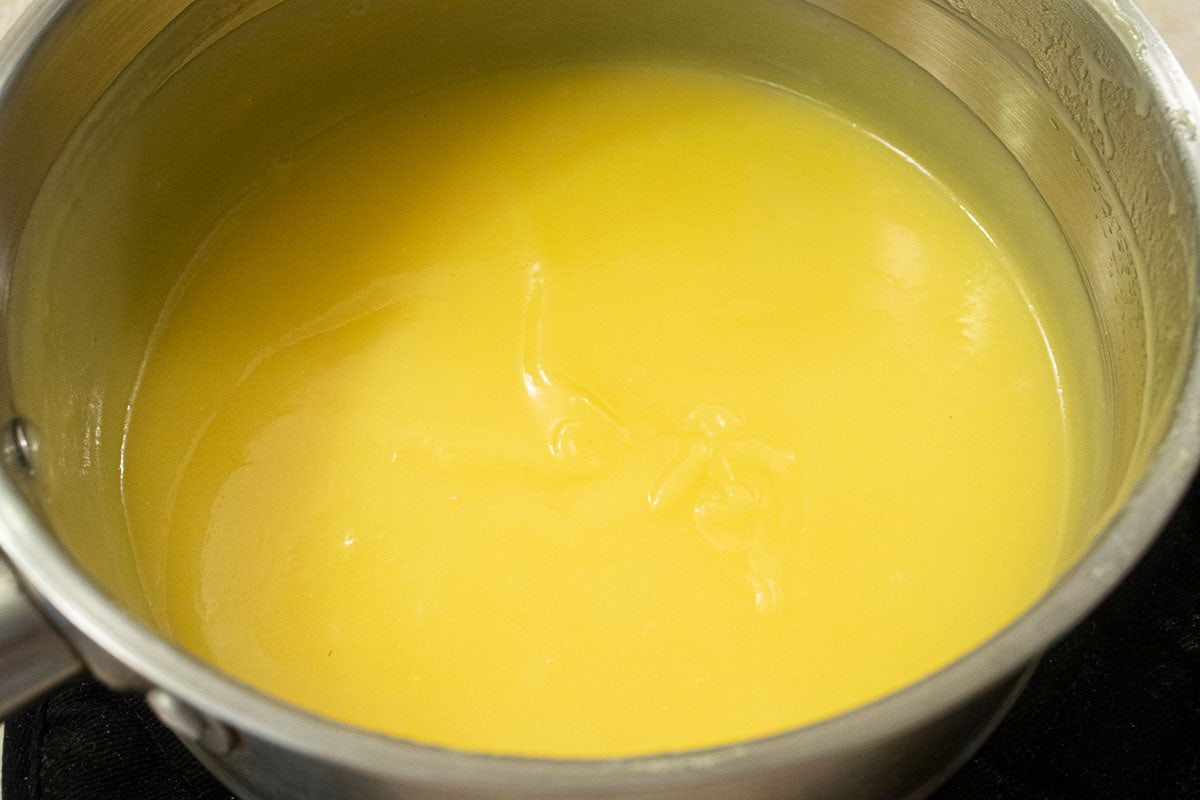
More Techniques about Baking
If you love How to Make Lemon Curd or any other recipe on my website, please please leave a 🌟 star rating in the recipe card and let me know how it went the 📝 comments below. I love hearing from you!
How to Make Lemon Curd
Ingredients
- 1 tablespoon water
- 1 ½ teaspoon gelatin, optional
- 2 large eggs
- 3 egg yolks
- ½ cup granulated sugar (100 grams)
- ½ cup freshly squeezed lemon juice
- ½ cup unsalted butter, cold (114 grams or 1 stick)
Instructions
- Dissolve the gelatin in the water. Stir to combine completely. Set aside.
- Place the eggs and yolks in a medium size bowl. Whisk to combine. Add the sugar and lemon juice. Strain it into the top of a double boiler.
- Cut the cold butter into 6 to 8 pieces. Add it to the egg mixture in the pan.
- Place over gently boiling water and, stirring constantly, heat to 172°F on a thermometer.
- Tear the gelatin into small pieces and add it directly to the hot curd. The heat will melt the gelatin. Whisk to incorporate it.
- Cover the surface directly with film and let it cool to room temperature.
- Store it in the refrigerator for up to a week or freeze for longer storage.
- Yield: 1 ⅔ cups


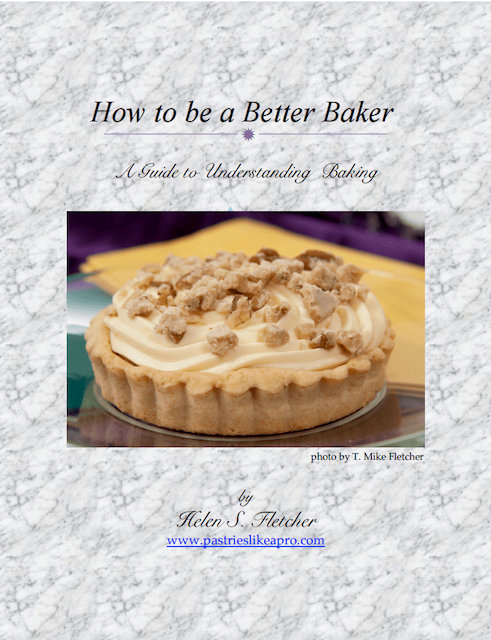
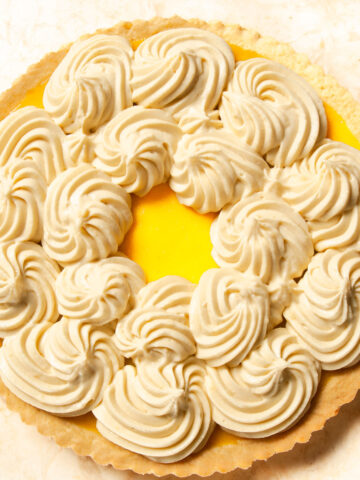
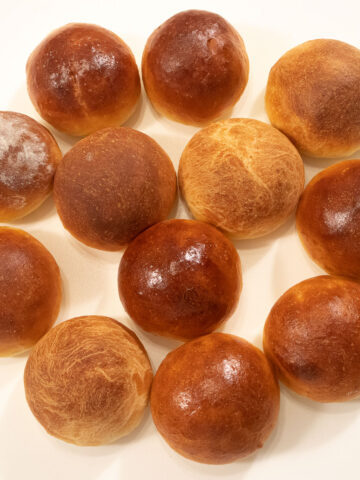

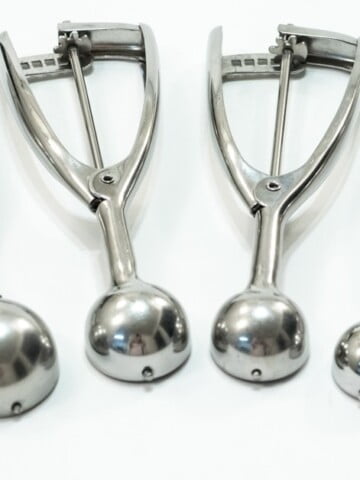
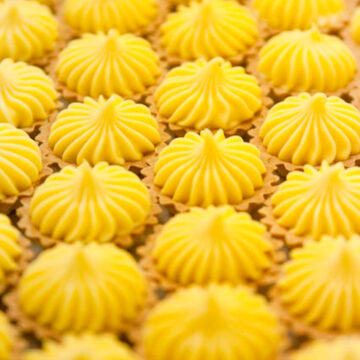


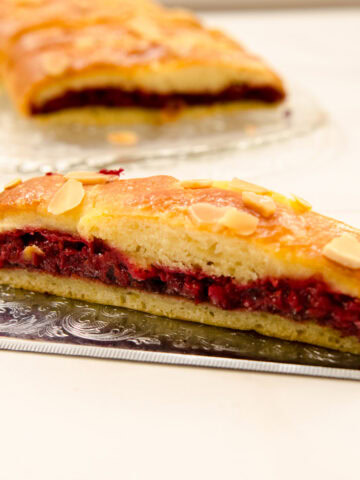
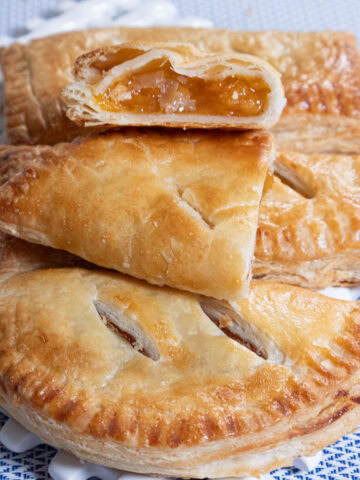
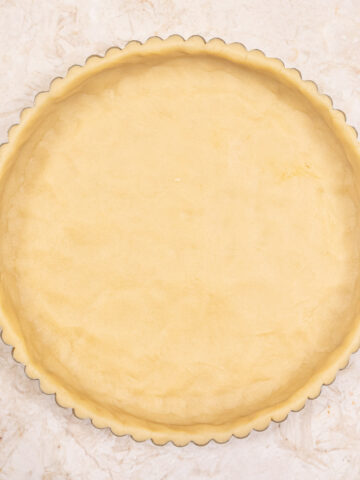
Cassie says
Hi,
I want to pipe this on top of a cookie after baking. Would this work? I would let the cookie cool first, but wondering if this recipe will hold its shape. Thanks in advance.
Helen S Fletcher says
Hi Cassie - As you can see in the photo, yes it holds its shape. But this is way too soft and needs to be refrigerated so I don't suggest it for a cookie finish.
Scott says
I wanted to make you aware of a discrepancy in your recipe. When anyone adjusts the servings number at the beginning of the recipe, the calculations adjust for everything EXCEPT the grams in the sugar and butter. It seems like a tech support issue, and it might cause followers to make big mistakes in your recipe production.
Helen S Fletcher says
Hi Scott, where do you see the ability to adjust the recipe. I have that turned off. Can you please send me a screen shot at [email protected]? I would very much appreciate it.
Kathy says
After taking and keeping and loving your recipe for pipeable pastry cream, I was looking for a firmer citrus curd and this ticks all the boxes, thank you! I do, however, have vegetarian family members. Would this work as well with agar agar? (I could try it myself, I suppose, but looking for the pro opinion first.)
Thank you in advance! Love your site. Love your recipes.
Helen S Fletcher says
Hi Kathy - thanks for the kind words. I don't really know. I haven't tried it with agar agar but I found this article which includes substituting agar agar for gelatin. Let me know how it goes if you use it. I would love to include it. Here is the website. https://www.capecrystalbrands.com/blogs/cape-crystal-brands/replacing-gelatin-with-agar-agar-a-comprehensive-guide
Kathy says
Thank you so much! I'll post a comment here if it works out!
Suzi says
Hi Helen!
Your recipe is wonderful. It’s missing the lemon additions though.
Helen S Fletcher says
Hi Suzi, Actually, it's missing the lemon juice and the sugar in the recipe card only. However, it is shown on Step 4 of the Step by Step instructions. Thanks for letting me know. I have corrected the recipe card.
Marlene Kaminski says
Have you ever experienced lemon curd with a metallic taste? I've looked into it on the internet, but can't find a definitive reason for it. Some say it's caused by using metal utensils and others say it's the ratio of the ingredients. What are your thoughts on the matter? I've made lemon curd several times, but am looking forward to trying your recipe.
hfletcher says
Hi Marlene, that occurs when you make it in an aluminum pot. The acid in the juice causes a reaction. It can also discolor it sometimes. I have all stainless steel lined or ceramic lined pans. This takes care of that problem. Glass is fine also.
Mary says
I have made Lemon Curd quite a lot over the years but I have never put Gelatin in it. I don’t suppose I have ever ‘decorated’ with it but have just put it in as a filling and covered it with something else. I shall try this soon as I am intrigued to see how it looks.
I have frozen Lemon Curd in the past and it has done well.
Thanks for your very informative Newsletters. :)
Gordon Bowman says
In the Lemon Curd recipe you specify 3/4 Butter. Is that 3/4 cup or 3/4 stick?
hfletcher says
Hi Gordon - thanks for bringing this to my attention. I have fixed it in the blog. It is 3/4 cup or 1 1/2 sticks.
Nikki says
Adding gelatin seems to make sense. And I never knew that a curd could be frozen for that bit of education I thank you..
Now I can't wait for the Lemon Meringue Loaf that is to come. Please tell me that it uses the 4 egg whites! If not I do make Coconut Macaroons that I have been known to add a bit of lemon curd to a little indentation I make in the top.
Again thank you for an excellent post and teaching me new "tricks"